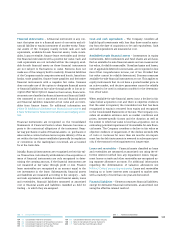Siemens 2011 Annual Report Download - page 274
Download and view the complete annual report
Please find page 274 of the 2011 Siemens annual report below. You can navigate through the pages in the report by either clicking on the pages listed below, or by using the keyword search tool below to find specific information within the annual report.
6 A. To our shareholders 51 C. Combined management’s discussion and analysis 23 B. Corporate Governance
predicted by these estimates is influenced e.g. by the success-
ful integration of acquired entities, volatility of capital mar-
kets, interest rate developments, foreign exchange rate fluc-
tuations and the outlook on economic trends. The recoverable
amount is the higher of the cash-generating unit’s fair value
less costs to sell and its value in use. The Company generally
uses discounted cash flow based methods to determine these
values. These discounted cash flow calculations use five-year
projections that are based on financial plannings. Cash flow
projections take into account past experience and represent
management’s best estimate about future developments.
Cash flows after the planning period are extrapolated using
individual growth rates. Key assumptions on which manage-
ment has based its determination of fair value less costs to
sell and value in use include estimated growth rates, weight-
ed average cost of capital and tax rates. These estimates, in-
cluding the methodology used, can have a material impact on
the respective values and ultimately the amount of any good-
will impairment. In fiscal , the company assessed the cur-
rent commercial feasibility of its solar and hydro business, the
level at which goodwill is monitored from the group perspec-
tive, as part of the Renewable Energy Division of the Energy
Sector and recorded a goodwill impairment loss of € mil-
lion. In fiscal , a goodwill impairment of €, million
was recognized in the Diagnostics Division of the Healthcare
Sector. See
Note
16 Goodwill for further information.
Likewise, whenever property, plant and equipment, other in-
tangible assets and investments accounted for using the eq-
uity method are tested for impairment, the determination of
the assets’ recoverable amount involves the use of estimates
by management and can have a material impact on the re-
spective values and ultimately the amount of any impairment.
In fiscal , Nokia Siemens Networks B.V. (NSN) presented
in the segment Equity Investments was tested for impair-
ment, which resulted in an impairment loss of €, million.
Whether future impairments of our investment in NSN will be
required is dependent on its ability to grow and / or otherwise
return to increasing profitability.
Measurement of non-current assets and disposal groups
classified as held for disposal – Assets held for disposal and
disposal groups are measured at the lower of their carrying
amount and their fair value less costs to sell. The determination
of the fair value less costs to sell may include the use of man-
agement estimates and assumptions that tend to be uncertain.
In fiscal , the disposal group Siemens IT Solutions and
Services was measured at fair value less costs to sell upon
classification as held for disposal and discontinued opera-
tion. The fair value was assumed to be represented by the
purchase price as negotiated between Siemens and Atos S.A.
(AtoS) including the consideration that AtoS committed itself
to pay for the transfer of Siemens IT Solutions and Services
less commitments entered into by Siemens. The valuation of
these commitments involves subjective judgment by man-
agement on the probability, timing and amount of these obli-
gations. These management estimates had an effect on the
amount of impairment losses recognized during fiscal
and on the deconsolidation result recognized in the fourth
quarter of fiscal . These estimates are subject to change
and thus any variation to the estimates could influence the
amount of the total loss on the disposal of Siemens IT Solu-
tions and Services presented within discontinued operations
beyond fiscal .
Employee benefit accounting – Pension plans and similar
commitments – Obligations for pension and other post-em-
ployment benefits and related net periodic benefit costs are
determined in accordance with actuarial valuations. These
valuations rely on key assumptions including discount rates,
expected return on plan assets, expected salary increases,
mortality rates and health care trend rates. The discount rate
assumptions are determined by reference to yields on high-
quality corporate bonds of appropriate duration and currency
at the end of the reporting period. In case such yields are not
available discount rates are based on government bonds
yields. Expected returns on plan assets assumptions are deter-
mined on a uniform methodology, considering long-term his-
torical returns and asset allocations. Due to changing market
and economic conditions the underlying key assumptions
may differ from actual developments and may lead to signifi-
cant changes in pension and other post-employment benefit
obligations. Such differences are recognized in full directly in
equity in the period in which they occur without affecting
profit or loss. See
Note
24 Pension plans and similar com-
mitments for further information.
Termination benefits – Siemens runs restructuring projects
on an individual basis. Costs in conjunction with terminating
employees and other exit costs are subject to significant esti-
mates and assumptions. See
Note
5 Restructuring expense
for further information.
























